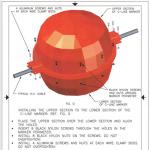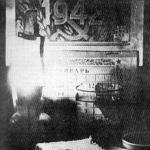The connection diagram of the transistor to the power supply is shown in Fig. 1, and the current-voltage characteristics of the transistor for various resistances of resistor R1 are shown in Fig. 2. This is how protection works. If the resistance of the resistor is zero (i.e., the source is connected to the gate), and the load consumes a current of about 0.25 A, then the voltage drop across the field-effect transistor does not exceed 1.5 V, and practically all of the rectified voltage will be across the load. When a short circuit appears in the load circuit, the current through the rectifier increases sharply and, in the absence of a transistor, can reach several amperes. The transistor limits the short circuit current to 0.45...0.5 A, regardless of the voltage drop across it. In this case, the output voltage will become zero, and all the voltage will drop across the field-effect transistor. Thus, in the event of a short circuit, the power consumed from the power source will increase in this example by no more than twice, which in most cases is quite acceptable and will not affect the “health” of the power supply parts.
Rice. 2
The short circuit current can be reduced by increasing the resistance of resistor R1. It is necessary to select a resistor such that the short circuit current is approximately twice the maximum load current.
This type of protection is especially convenient for power supplies with a smoothing RC filter - then the field-effect transistor is switched on instead of the filter resistor (such an example is shown in Fig. 3).
Since during a short circuit almost all of the rectified voltage drops across the field-effect transistor, it can be used for light or sound signaling. Here, for example, is a diagram for turning on the light alarm - Fig. 7. When everything is in order with the load, the green HL2 LED lights up. In this case, the voltage drop across the transistor is not enough to light the HL1 LED. But as soon as a short circuit appears in the load, the HL2 LED goes out, but the red HL1 flashes.

Rice. 3
Resistor R2 is selected depending on the desired short-circuit current limitation according to the recommendations made above.
The connection diagram for the sound alarm is shown in Fig. 4. It can be connected either between the drain and source of the transistor, or between the drain and gate, like the HL1 LED.
When sufficient voltage appears on the signaling device, the AF generator, made on a unijunction transistor VT2, comes into operation, and a sound is heard in the headphone BF1.
The unijunction transistor can be KT117A-KT117G, the telephone can be low-impedance (can be replaced with a low-power dynamic head).

Rice. 4
It remains to add that for low-current loads, a short-circuit current limiter using a field-effect transistor KP302V can be inserted into the power supply. When choosing a transistor for other blocks, you should take into account its permissible power and drain-source voltage.
Of course, such automation can also be introduced into a stabilized power supply that does not have short-circuit protection in the load.
The simplest short circuit protection is relevant for both experienced and novice radio amateurs, since no one is immune from errors. This article provides a simple but very original diagram that will help you protect your device from unwanted failure. The self-resetting fuse de-energizes the circuit, and the LEDs signal an emergency, quickly, reliably and simply.
Short circuit protection circuit:
The circuit shown in Figure 1 is a very easy-to-set up protection for an amateur radio power supply or any other circuit.
 Figure No. 1 – Short circuit protection circuit.
Figure No. 1 – Short circuit protection circuit. Operation of short circuit protection circuit:
The scheme is very simple and understandable. Since the current flows along the path of least resistance while the fuse FU1 is intact, the output load Rн (Figure No. 2) is connected and current flows through it. In this case, the VD4 LED is constantly lit (preferably green).
 Figure No. 2 - Operation of the circuit with a full fuse
Figure No. 2 - Operation of the circuit with a full fuse If the load current exceeds the maximum current permissible for the fuse, it trips, thereby breaking (bypassing) the load circuit, Figure No. 3. In this case, LED VD3 lights up (red) and VD4 goes out. In this case, neither your load nor the circuit suffers (of course, provided that the fuse trips in a timely manner).
 Figure No. 3 – The fuse has tripped
Figure No. 3 – The fuse has tripped Diodes VD1, VD5 and zener diode VD2 protect LEDs from reverse currents. Resistors R1, R2 limit the current in the protection circuit. For fuse FU1, I recommend using a self-resetting fuse. And you select the values of all elements of the circuit depending on your needs.
A protection design for any type of power supply is presented. This protection circuit can work together with any power supply - mains, switching and DC batteries. The schematic decoupling of such a protection unit is relatively simple and consists of several components.
Power supply protection circuit
The power part - a powerful field-effect transistor - does not overheat during operation, therefore it does not need a heat sink either. The circuit is at the same time a protection against power overload, overload and short circuit at the output, the protection operation current can be selected by selecting the resistance of the shunt resistor, in my case the current is 8 Amperes, 6 resistors of 5 watts 0.1 Ohm connected in parallel were used. The shunt can also be made from resistors with a power of 1-3 watts.
The protection can be more accurately adjusted by selecting the resistance of the trimming resistor. Power supply protection circuit, current limit regulator Power supply protection circuit, current limit regulator
~~~In the event of a short circuit and overload of the unit output, the protection will instantly operate, turning off the power source. An LED indicator will indicate that the protection has been triggered. Even if the output short-circuits for a couple of tens of seconds, the field-effect transistor remains cold
~~~The field-effect transistor is not critical; any switches with a current of 15-20 Amps or higher and an operating voltage of 20-60 Volts will do. Keys from the IRFZ24, IRFZ40, IRFZ44, IRFZ46, IRFZ48 line or more powerful ones - IRF3205, IRL3705, IRL2505 and the like are ideal.
~~~This circuit is also great for protecting a charger for car batteries; if the connection polarity is suddenly reversed, then nothing bad will happen to the charger; the protection will save the device in such situations.
~~~Thanks to the fast operation of the protection, it can be successfully used for pulsed circuits; in the event of a short circuit, the protection will operate faster than the power switches of the switching power supply have time to burn out. The circuit is also suitable for pulse inverters, as current protection. If there is an overload or short circuit in the secondary circuit of the inverter, the inverter's power transistors instantly fly out, and such protection will prevent this from happening.
Comments
Short circuit protection, polarity reversal and overload are assembled on a separate board. The power transistor was used in the IRFZ44 series, but if desired, it can be replaced with a more powerful IRF3205 or with any other power switch that has similar parameters. You can use keys from the IRFZ24, IRFZ40, IRFZ46, IRFZ48 line and other keys with a current of more than 20 Amps. During operation, the field-effect transistor remains icy. therefore it does not need a heat sink.

The second transistor is also not critical; in my case, a high-voltage bipolar transistor of the MJE13003 series was used, but there is a large choice. The protection current is selected based on the shunt resistance - in my case, 6 0.1 Ohm resistors in parallel, the protection is triggered at a load of 6-7 Amps. You can set it more precisely by rotating the variable resistor, so I set the operating current to around 5 Amps.

The power of the power supply is quite decent, the output current reaches 6-7 Amps, which is quite enough to charge a car battery.
I chose shunt resistors with a power of 5 watts, but 2-3 watts is also possible.



If everything is done correctly, the unit starts working immediately, close the output, the protection LED should light up, which will light up as long as the output wires are in short-circuit mode.
If everything works as it should, then we proceed further. Assembling the indicator circuit.

The circuit is copied from a battery screwdriver charger. The red indicator indicates that there is output voltage at the power supply output, the green indicator shows the charging process. With this arrangement of components, the green indicator will gradually go out and finally go out when the voltage on the battery is 12.2-12.4 Volts; when the battery is disconnected, the indicator will not light up. 
Modern power switching transistors have very low drain-source resistances when on, which ensures low voltage drop when large currents pass through this structure. This circumstance allows the use of such transistors in electronic fuses.
For example, the IRL2505 transistor has a drain-source resistance, with a source-gate voltage of 10V, only 0.008 Ohms. At a current of 10A, the power P=I² R will be released on the crystal of such a transistor; P = 10 10 0.008 = 0.8 W. This suggests that at a given current the transistor can be installed without using a radiator. Although I always try to install at least small heat sinks. In many cases, this allows you to protect the transistor from thermal breakdown in emergency situations. This transistor is used in the protection circuit described in the article “”. If necessary, you can use surface-mounted radioelements and make the device in the form of a small module. The device diagram is shown in Figure 1. It was calculated for a current of up to 4A.
Electronic fuse diagram
In this circuit, a field-effect transistor with a p channel IRF4905 is used as a key, having an open resistance of 0.02 Ohm, with a gate voltage = 10V.
In principle, this value also limits the minimum supply voltage of this circuit. With a drain current of 10A, it will generate a power of 2 W, which will entail the need to install a small heat sink. The maximum gate-source voltage of this transistor is 20V, therefore, to prevent breakdown of the gate-source structure, a zener diode VD1 is introduced into the circuit, which can be used as any zener diode with a stabilization voltage of 12 volts. If the voltage at the input of the circuit is less than 20V, then the zener diode can be removed from the circuit. If you install a zener diode, you may need to adjust the value of resistor R8. R8 = (Upit - Ust)/Ist; Where Upit is the voltage at the circuit input, Ust is the stabilization voltage of the zener diode, Ist is the zener diode current. For example, Upit = 35V, Ust = 12V, Ist = 0.005A. R8 = (35-12)/0.005 = 4600 Ohm.
Current-voltage converter
Resistor R2 is used as a current sensor in the circuit, in order to reduce the power released by this resistor; its value is chosen to be only one hundredth of an Ohm. When using SMD elements, it can be composed of 10 resistors of 0.1 Ohm, size 1206, with a power of 0.25 W. The use of a current sensor with such a low resistance entailed the use of a signal amplifier from this sensor. The DA1.1 op amp of the LM358N microcircuit is used as an amplifier.
The gain of this amplifier is equal to (R3 + R4)/R1 = 100. Thus, with a current sensor having a resistance of 0.01 Ohm, the conversion coefficient of this current-voltage converter is equal to unity, i.e. One ampere of load current is equal to a voltage of 1V at output 7 DA1.1. You can adjust the Kus with resistor R3. With the indicated values of resistors R5 and R6, the maximum protection current can be set within.... Now let's count. R5 + R6 = 1 + 10 = 11kOhm. Let's find the current flowing through this divider: I = U/R = 5A/11000Ohm = 0.00045A. Hence, the maximum voltage that can be set at pin 2 of DA1 will be equal to U = I x R = 0.00045A x 10000 Ohm = 4.5 V. Thus, the maximum protection current will be approximately 4.5A.
Voltage comparator
A voltage comparator is assembled on the second op-amp, which is part of this MS. The inverting input of this comparator is supplied with a reference voltage regulated by resistor R6 from stabilizer DA2. Non-inverting input 3 of DA1.2 is supplied with amplified voltage from the current sensor. The load of the comparator is a series circuit, an optocoupler LED and a damping adjustment resistor R7. Resistor R7 sets the current passing through this circuit, about 15 mA.
Circuit operation
The scheme works as follows. For example, with a load current of 3A, a voltage of 0.01 x 3 = 0.03V will be released at the current sensor. The output of amplifier DA1.1 will have a voltage equal to 0.03V x 100 = 3V. If in this case, at input 2 of DA1.2 there is a reference voltage set by resistor R6, less than three volts, then at the output of comparator 1 a voltage will appear close to the supply voltage of the op-amp, i.e. five volts. As a result, the optocoupler LED will light up. The optocoupler thyristor will open and bridge the gate of the field-effect transistor with its source. The transistor will turn off and turn off the load. You can return the circuit to its original state with the SB1 button or by turning the power supply off and on again.
Almost every novice radio amateur strives at the beginning of his creativity to design a network power supply in order to subsequently use it to power various experimental devices. And of course, I would like this power supply to “tell” about the danger of failure of individual components due to installation errors or malfunctions.
Today there are many schemes, including those with indication of a short circuit at the output. In most cases, such an indicator is usually an incandescent lamp connected to the load break. But by such inclusion we increase the input resistance of the power source or, more simply, we limit the current, which in most cases, of course, is acceptable, but is not at all desirable.
The circuit shown in Fig. 1 not only signals a short circuit without affecting the output impedance of the device at all, but also automatically turns off the load when the output is shorted. In addition, LED HL1 reminds that the device is plugged in, and HL2 lights up when fuse FU1 blows, indicating the need to replace it.
Electrical circuit diagram of a homemade power supply with short circuit protection
Consider the operation of a homemade power supply. The alternating voltage removed from the secondary winding T1 is rectified by diodes VD1...VD4, assembled in a bridge circuit. Capacitors C1 and C2 prevent the penetration of high-frequency interference into the network, and the oxide capacitor C3 smoothes out the voltage ripples supplied to the input of the compensation stabilizer, assembled at VD6, VT2, VT3 and providing a stable output voltage of 9 V.
The stabilization voltage can be changed by selecting the VD6 zener diode, for example, with KS156A it will be 5 V, with D814A - 6 V, with DV14B - V V, with DV14G -10 V, with DV14D -12 V. If desired, the output voltage can be made adjustable, To do this, a variable resistor with a resistance of 3-5 kOhm is connected between the anode and cathode VD6, and the base VT2 is connected to the motor of this resistor.
Let's consider the operation of the power supply protective device. The short-circuit protection unit in the load consists of a germanium pnp transistor VT1, electromagnetic relay K1, resistor R3 and diode VD5. The latter in this case serves as a stabistor that maintains a constant voltage of about 0.6 - 0.7 V based on VT1 relative to the total.
In normal mode of operation of the stabilizer, the transistor of the protection unit is securely closed, since the voltage at its base relative to the emitter is negative. When a short circuit occurs, the emitter of VT1, like the emitter of the regulating VT3, is connected to the common negative wire of the rectifier.
In other words, the voltage at its base relative to the emitter becomes positive, as a result of which VT1 opens, K1 is triggered and turns off the load with its contacts, and the HL3 LED lights up. After eliminating the short circuit, the bias voltage at the emitter junction VT1 again becomes negative and it closes, relay K1 is de-energized, connecting the load to the output of the stabilizer.
Parts for making a power supply. Any electromagnetic relay with the lowest possible operating voltage. In any case, one indispensable condition must be met: the secondary winding T1 must produce a voltage equal to the sum of the stabilization and relay response voltages, i.e. if the stabilization voltage, as in this case, is 9 V, and U of the relay is 6 V, then the secondary winding must have at least 15 V, but not exceed the permissible value at the collector-emitter of the transistor used. The author used TVK-110L2 as T1 on the prototype. The printed circuit board of the device is shown in Fig. 2.
Power supply circuit board




















